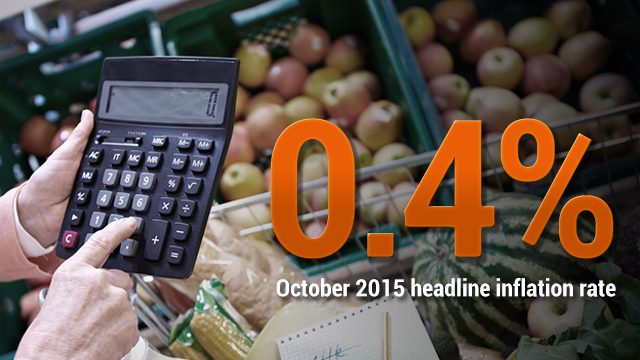SUMMARY
This is AI generated summarization, which may have errors. For context, always refer to the full article.

MANILA, Philippines – Headline inflation in October stabilized at 0.4% following a 3-month consecutive drop to less than 1%, the National Economic and Development Authority (NEDA) reported on Thursday, November 5.
Inflation, the rate at which prices of goods and services rise, has steadily eased – from 2.5% in February, 2.4% in March, 2.2% in April, 1.6% in May, 1.2% in June, 0.8% in July, 0.6% in August, and a record fall to 0.4% in September.
The Philippine Statistics Authority said Thursday the October headline inflation rate remained well within the Bangko Sentral ng Pilipinas‘ (BSP) forecast of 0.1%-0.9% for the period. This is also lower than the 3.2% recorded in October 2014.
“Our current runs show inflation is possibly bottoming out, and it will gradually move to within target range in 2016 and 2017,” BSP Governor Amando M. Tetangco Jr said in a text message.
“The current low inflation environment is expected to continue throughout the year. This will largely be due to favorable supply-side factors such as the availability of ample food supply and low international oil prices,” said Economic Planning Secretary Arsenio M. Balisacan.
Meanwhile, Barclays economist Rahul Bajoria said the bank slashed its inflation forecast to 1.4% instead of 1.6% this year, and to 2.4% instead of 2.7% next year.
“Our new forecasts incorporate slower core inflation and also a more modest increase in energy costs in 2016, as oil prices are likely to rise only gradually. We believe the medium-term risks to inflation center on El Niño and its potential impact on agricultural prices,” he said.
Core inflation, which excludes energy and unprocessed food prices, slightly increased to 1.5% in October, from 1.4% in September.
But year-to-date core inflation slowed down to 2% relative to the 2.1% average in September.
“This indicates that price adjustments across a broad range of consumer items are relatively stable,” said Balisacan, who is also NEDA Director-General.
Stable
The annual inflation in the country’s food alone index remained at its previous month’s rate of 0.7%. In October 2014, it was observed at 7.2%.
Inflation for the food subgroup remained stable in October 2015 due to large price declines in bread, cereal, corn, and rice.
“These offset the slight price increase in some food items such as meat and vegetables on account of the damage caused by Typhoon Lando which affected supply,” Balisacan said.
The annual growth in the meat index went up to 0.7% in October, fish and food products not elsewhere classified indices, 3%; vegetable index, 3.2%; and sugar, jam, honey, chocolate, and confectionery index, 3.1%.
PSA also reported a higher annual growth registered in alcoholic beverages and tobacco index at 3.7% in October.
Non-food items also showed slight price increments as inflation partially increased by 0.2% in October 2015.
Lower prices in electricity, gas, and other fuels also continued due to lower generation charge in October 2015.
Prices of gasoline, kerosene, diesel, and LPG also remained relatively lower due to the still cheaper international crude oil prices. Other commodity groups had slower annual add-ons or retained their previous month’s rates except for housing, water, electricity, gas, and other fuels index that continued to post a negative rate of 2.1%.
Clothing and footwear index meanwhile registered 2.2%; health index, 1.7%; and transport index, 0.1%.
Risks mounting
Both Balisacan and Tetangco said that while the environment remains favorable for low inflation, Balisacan warned of the “upside risks” of El Niño and its impact on consumer prices.
“Upside risks could come from the stronger and prolonged El Niño’s impact on food prices and also possible increase in utility rates given the pending petitions for power rate adjustments,” Balisacan said.
For this, part, Tetangco said, “While there seems to be room to ease given the relatively lower inflation at the moment, risks to the outlook remain including El Niño and pending requests for utility rate hikes.”
Balisacan added that there must be continued monitoring of drought in agricultural areas. “There is a need to ensure supply adequacy and to intensify local community efforts in areas that are highly vulnerable and exposed to adverse impacts of a prolonged dry spell,” he said.
He added that drier weather conditions on account of El Niño could adversely affect hydro-powered generation plants and raise the cost of electricity, particularly in Mindanao.
“It is also important that the on-going power projects that are expected to be delivered between November 2015 and March 2016 will not be delayed. This will ensure that inflationary pressure coming from power shortages is tempered,”Balisacan said.
For its part, the BSP’s Monetary Board is scheduled to hold a policy-setting meeting on Thursday, November 12. The central bank kept policy rates unchanged in anticipation of an inflation rate that’s lower than target this year.
Tetangco said domestic demand remains steady and there is no need for further monetary support at this point.
“We need to balance these versus domestic liquidity conditions, especially as market anticipates Fed (US Federal Reserve) action toward year-end. We will make adjustments to policy as conditions warrant,” the BSP chief said. – Rappler.com
Add a comment
How does this make you feel?
There are no comments yet. Add your comment to start the conversation.